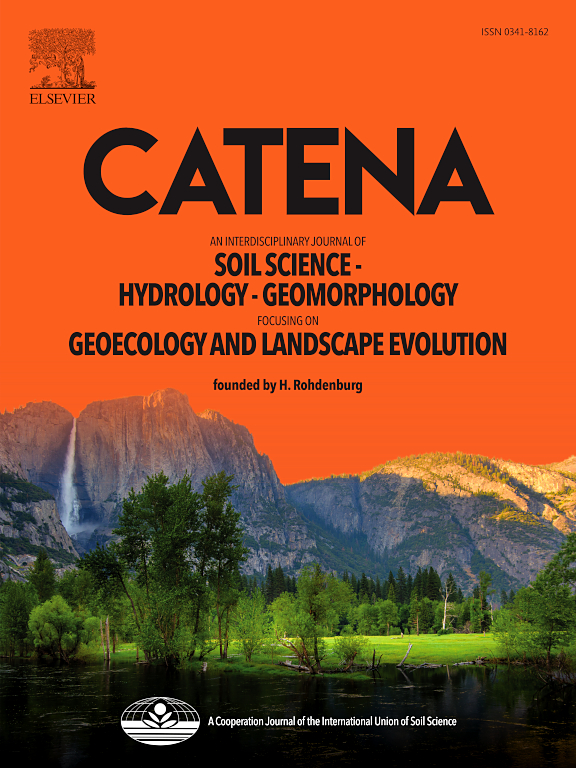有机-金属共沉淀有助于红树林土壤有机碳组分的稳定
IF 5.7
1区 农林科学
Q1 GEOSCIENCES, MULTIDISCIPLINARY
引用次数: 0
摘要
预测人为干扰和全球变化对红树林土壤有机碳(OC)库的影响需要详细了解OC稳定的机制。本研究采用密度分选技术对不同矿物组合和保护程度的OC组分进行物理分离,旨在评估这些组分的分布以及影响最具优势和难选矿物伴生的高密度组分(HF)的地球化学因素。我们在日本石垣岛的gabumurata红树林进行了全森林范围的土壤采样,沿着三个样带(上游、中游、下游)和五个深度(直到100厘米)进行采样。HF (OCHF)中OC最老(Δ14C中值为- 13.81‰),对土壤体积OC(43% ~ 63%)和全氮(64% ~ 85%)贡献最大。在不同结晶度的可提取金属(铝[Al]、铁[Fe]、钙[Ca]、镁[Mg])中,只有有机络合的Al和Fe与OCHF呈较强的正相关。这些结果表明,OC和Fe的共沉淀是有机-矿物结合的主要模式,而高的OCHF:Fe比超过了Fe氧化物的最大吸附能力。粘土含量低降低了Ca和Mg对OCHF的重要性,因为这些二价阳离子通常通过带负电荷的粘土表面和有机物之间的阳离子桥接来促进OC的稳定。此外,Δ14C-OC关系表明,除了原有的老碳,红树林衍生的现代碳也有效地融入到HF中。因此,红树林的扩张可能会增强稳定的土壤碳库,增加植物生物量和凋落物。总体而言,本研究提出了红树林OC稳定形成和维持的生物地球化学机制,并对全球红树林扩张和种植工作产生影响。本文章由计算机程序翻译,如有差异,请以英文原文为准。
Organo-metal coprecipitation contributes to stable organic carbon fraction in mangrove soil
Prediction of the impact of anthropogenic disturbances and global change on Organic Carbon (OC) pools in mangrove soils requires a detailed understanding of the mechanisms underlying OC stabilization. Using density fractionation to physically separate OC fractions with varying degrees of mineral association and protection, this study aimed to assess distributions of these fractions and the geochemical factors influencing the most dominant and refractory mineral-associated, High-density Fraction (HF). We conducted forest-wide soil sampling in the Gaburumata mangrove forest on Ishigaki Island, Japan, along three transects (upstream, midstream, downstream) and at five depths (until 100 cm). The OC in HF (OCHF) was the oldest (median Δ14C value of −13.81 ‰) and contributed most significantly to bulk soil OC (43 %-63 %) and total nitrogen (64 %-85 %). Among the extractable metals analyzed (aluminum [Al], iron [Fe], calcium [Ca], and magnesium [Mg]) with different crystallinity, only organically complexed Al and Fe showed strong positive correlations with OCHF. Together with high OCHF:Fe ratios that surpassed the maximum sorptive capacity of Fe oxides, these results indicate that co-precipitation of OC and Fe was the dominant mode of organo-mineral associations. The low clay content reduced the importance of Ca and Mg on OCHF, as these divalent cations typically facilitate OC stabilization through cation bridging between negatively charged clay surfaces and organic matter. Furthermore, the Δ14C–OC relationship suggested efficient incorporation of mangrove-derived modern C into HF, in addition to the pre-existing old C. Thus, mangrove expansion may enhance stable soil OC pools as well as increase plant biomass and litter. Overall, this study proposes a biogeochemical mechanism for how stable mangrove OC is newly formed, as well as maintained, with ramifications for global mangrove expansion and plantation efforts.
求助全文
通过发布文献求助,成功后即可免费获取论文全文。
去求助
来源期刊

Catena
环境科学-地球科学综合
CiteScore
10.50
自引率
9.70%
发文量
816
审稿时长
54 days
期刊介绍:
Catena publishes papers describing original field and laboratory investigations and reviews on geoecology and landscape evolution with emphasis on interdisciplinary aspects of soil science, hydrology and geomorphology. It aims to disseminate new knowledge and foster better understanding of the physical environment, of evolutionary sequences that have resulted in past and current landscapes, and of the natural processes that are likely to determine the fate of our terrestrial environment.
Papers within any one of the above topics are welcome provided they are of sufficiently wide interest and relevance.
 求助内容:
求助内容: 应助结果提醒方式:
应助结果提醒方式:


